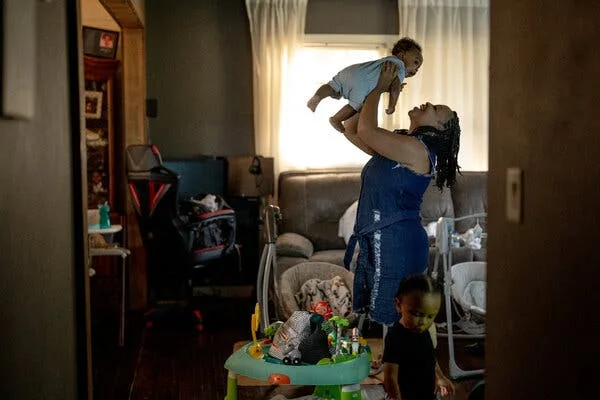Gabrielle Glaze felt scolded and shamed when she delivered her first son in a Birmingham, Ala., hospital, forced to observe strict rules about lying stationary through her contractions and enduring countless cervical checks from “total strangers” who seemed disappointed by her body’s progress.
So when Ms. Glaze, 33, gave birth to a second son in a birthing center in April, surrounded by a team of midwives who said they would let her body lead the way, it seemed as if her previous labor experience had finally been redeemed.
Ms. Glaze found herself telling every woman she knew about Oasis Family Birthing Center in Birmingham, which was run by an obstetrician and midwives — many of them Black, like her — and encouraged patients through an unhurried, uninterrupted, natural labor process. She said it seemed like the answer to centuries of birthing trauma among Black women, providing medical expertise in a culturally familiar space, with the hope of improving both birthing experiences and health outcomes for women of color.
But Ms. Glaze was one of the last women to deliver at the facility. In June, the Alabama Department of Public Health shut it down, despite its record of smooth deliveries with no complications. State regulators are now weeks away from instituting new birth center licensing rules that would make it nearly impossible for similar facilities to open and operate.
“If these rules are not implemented, there will be fewer safeguards and standards for the operation of these facilities, exposing mothers and their newborns to increased risks to their health and safety,” a public draft of the new policy says.
Oasis and two other birth centers seeking to operate have sued the state with the help of the A.C.L.U., seeking to overturn the closure and create a path for others to open. A trial to determine their fate began on Thursday.

In a state like Alabama, which has the third-highest maternal death rate and the sixth-highest infant death rate in the United States, some public health experts see birth centers as a potential solution to a gut-wrenching problem: Almost two-thirds of counties in Alabama have little to no local maternity care options. Next month, two labor and delivery units in the Birmingham area are set to close, including the last remaining unit in one of Alabama’s largest counties. Black mothers and infants make up a disproportionate share of bad health outcomes.
Research is limited, but free-standing birth centers, which take only low-risk patients, are associated with lower rates of preterm delivery, higher birth weights, lower rates of cesarean sections, increased breastfeeding rates and about $2,000 in Medicaid savings per patient, compared with traditional care, according to a multiyear study conducted by the federal government.
Across the United States, which has the highest maternal mortality rate in the industrialized world, receptivity toward birth centers varies. Some states, including Minnesota and Florida, have embraced the facilities so long as they meet national standards and the Commission for the Accreditation of Birth Centers recognizes them. Texas has at least 80 free-standing birth centers, run primarily by licensed midwives.
But in other states, including Mississippi and Kentucky, birthing centers face a battle similar to the one in Alabama. Officials in Georgia recently denied approval for a birth center in Augusta despite broad public support, because local hospitals refused to sign patient transfer agreements.
A spokeswoman for the Alabama Department of Public Health declined to comment on either the shutdown of Oasis or the state’s new birthing center regulations, citing continuing litigation.
Dr. Heather Skanes, the obstetrician and gynecologist who ran Oasis, said the department notified her in a phone call that the facility needed a hospital license to operate, but when she asked for a path to licensure, the department declined to provide one. The lawsuit against the department argues that this is an unlawful “de facto ban.”
The new regulations, set to take effect Oct. 15, require a physician to be on call to commute into the facility in case of an emergency, a delay that midwives say would endanger a patient in need of a speedy transfer to higher-level care. The birth center will also be required to have a written transfer agreement with a hospital — a document the midwives say is unnecessary, since federal law requires hospitals to accept women in active labor.
Birthing centers must also be within a 30-minute drive of a hospital with obstetricians on staff. About 28 percent of women in Alabama have no birthing hospital within 30 minutes.
“The rules are designed to provide for the health and safety of mothers in the prenatal, delivery and postnatal stages of the childbirth experience, as well as the health and safety of their newborns,” the draft of the new policy states.
Kate Bauer, the executive director of the American Association of Birth Centers, which sets national standards for the facilities, said the new rules in Alabama were “out of touch with the evidence for well-functioning birth centers.”
Supporters of birth centers, where deliveries more than doubled from 2004 to 2017 and continued to rise during the Covid pandemic, said they believed officials were blocking the centers because of longstanding conflicts of interest with the state’s medical establishment. Birth center deliveries, which often cost around $6,000, could be considered competition for hospitals, where delivering a baby can bring in more than $20,000.
“You would think that Alabama would be tired of being at the bottom of the barrel with maternal health outcomes and disparities, and wouldn’t actively stand in the way of us fixing them,” said Stephanie Mitchell, a midwife who is planning to open a rural birthing facility in western Alabama in the coming months. She has joined the lawsuit against the state’s health department.
Birth centers aren’t necessarily for everyone, said Katy Kozhimannil, the director of the Rural Health Research Center at the University of Minnesota, who studies health equity in childbirth. But they are a lifeline for communities with barriers to good maternity care — whether those barriers are geographic, financial or cultural.
Dr. Skanes opened Oasis in June 2022
said she vetted applicants using national criteria to ensure their deliveries would be low risk. She equipped the facility with emergency supplies for hemorrhages, resuscitations and patient transfers, just in case. (She ultimately never used them.)
. It was a particularly appealing option for Black women, who made up a large majority of the center’s patients and who are, research has found, significantly more likely to report mistreatment during childbirth, such as being ignored, shouted at or denied care.
Jakiera Lucy, 30, learned about Oasis through Chocolate Milk Mommies, a support group for Black mothers seeking to breastfeed. Her birth plan had been largely ignored when she delivered her first child in a hospital, she said — she still gets shivers down her spine when someone mentions the facility — and when the birth of her second child came around, she was still paying for the first.
At Oasis, Ms. Lucy’s husband, Jay, learned how to release the tension in her hips during contractions and support her labor on a yoga ball. Ms. Lucy delivered in a teal pool, surrounded by glowing string lights and a team of midwives in T-shirts and sneakers. Photographs from the moment after the birth show her leaning back in the tub, baby on her chest, beaming.
“This is back to our roots — back to what our grandmothers did — before we were forced into hospitals that hand out pamphlets where the white women have husbands and the Black women are always alone,” Ms. Lucy said.
The state’s decision to shut down the birth center is particularly devastating, she said, because it is a deciding factor for her and her husband on whether they will have another child. “It’s like a carrot was dangling, and then it got snatched away.”
For Ms. Mitchell, the midwife aiming to open the rural birthing center in western Alabama, the staffing and distance requirements of the new rules are disqualifying. The tiny town of Gainesville (population: 174), in the heart of Alabama’s Black Belt, originally named for its rich, dark soil, is 37 miles from the nearest hospital labor and delivery ward, with no other midwives listed in the county.
“They’re putting me in an ethical dilemma, where I’m going to have to pick between offering a service that saves lives and actually following the law,” she said. “So I guess they’ll have to haul me off to jail.”
She worked for years to raise money to purchase a two-story antebellum house near a bandstand that local lore says was used to sell enslaved people, and renovate it into a full-service birthing center called Birth Sanctuary. She plans to open in January.
On a recent afternoon, Ms. Mitchell, who has a doctoral degree in nursing, walked through Birth Sanctuary to the echoes of cicadas, to check the progress of the new floor plan, complete with a hydrotherapy room and a full kitchen to keep the laboring women nourished. Outside, she sat beneath a weeping willow, considering how the fate of her vision was now in question.
Ms. Mitchell quickly learned of Alabama’s longstanding aversion to midwifery when she moved to Gainesville from Boston in 2020. The state outlawed the practice in the 1970s, and several midwives who attended out-of-hospital births were charged with crimes. Midwives could not legally assist women in giving birth outside of hospitals in the state until 2017.
She believes the new rule is no coincidence, given the deep ties that have long existed between the state’s public health officials and the traditional medical establishment. Even today, the state health officer — appointed in most states by the governor or a governor’s board — is still appointed largely by representatives from the state’s medical association.
Several members of Alabama Department of Public Health’s Licensure Advisory Board, which approved the text of the new regulations, are directly appointed by the state’s medical association, which represents doctors, or its hospital association. Twelve of the 16 board members on the public health committee — which voted to move forward with the regulations despite a public hearing with more than 70 unanimous objections — are appointed by the medical association.
And six members of the legislative council, the group of Alabama lawmakers that holds the power to stop the regulations from taking effect, received financial contributions from the state’s medical political action committee during the 2022 election cycle.
Mark Jackson, the executive director of the medical association, said the group did not submit comments or participate in the drafting of the new regulations, but that “the top concern of physicians is the health and well-being of patients. Consequently, we want all health services provided outside of a hospital setting to be as risk-averse as possible.”
The officials who shepherded the regulations through included a veterinarian, dentist, psychiatrist, urologist and at least four hospital chief executives — but no midwives.
“If this was really about safety, there would be some effort to involve those of us who actually do this work,” Dr. Skanes said.
At Oasis, the lights are still out, but Karneshia Jemison, 32, still comes by to see Dr. Skanes in the room where she had planned to deliver her baby in next month. The shelves are fully stocked — expired medicines routinely replaced with fresh ones, just in case.


